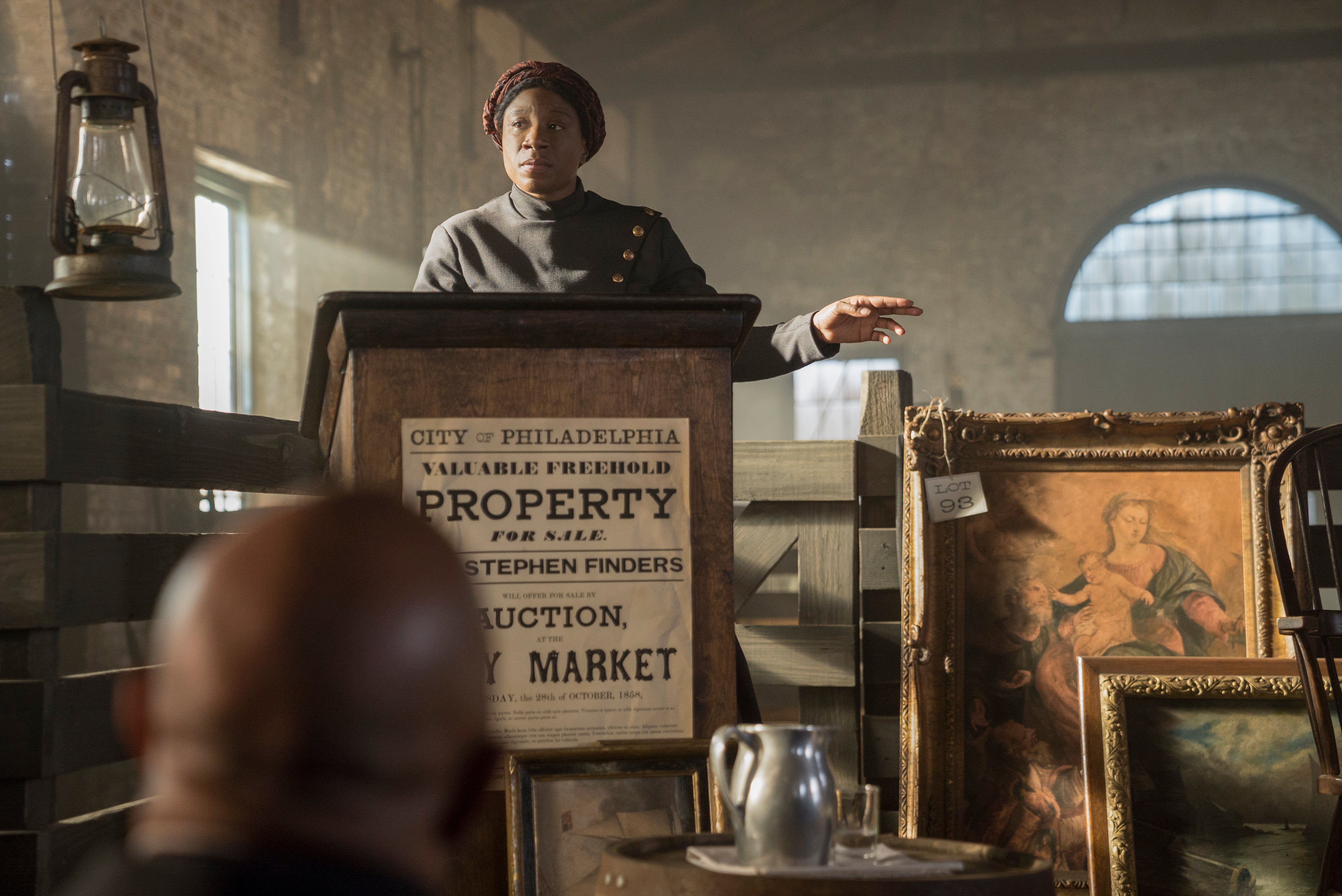
As a guide, warrior and no-nonsense champion, Aisha Hinds’ Harriet Tubman has been a visceral force during this season of Underground. Teaching Rosalee how to move cargo undetected and working with Georgia and Elizabeth’s abolitionist sewing circle, “the most notorious runaway” has integrated herself among all aspects of the cause and in “Minty,” we finally get the full view of her life and backstory. In an unprecedented move on television, Underground chose to put the spotlight on one character to drive the entire episode, and Hinds’ performance was exhilarating and masterful to watch.
In a 19th century “TED Talk” of sorts, the audience meets the woman behind the legend as she paints an intricate tapestry of her childhood and how she became General Tubman. Born Araminta Ross around 1820, Tubman discusses the sisters that were sold away from her, and the horrendous abuse that she suffered as a child after bring hired out by her master to different estates. Even as a young girl, though she was often sickly, Harriet had a rebellious streak. She was mischievous and would use small acts of defiance to assert herself despite the conditions of her bondage. For Harriet Tubman, Harriet Beacher Stowe’s 1852 novel, Uncle Tom’s Cabin didn’t even scratch the surface of the horrors of slavery.
For Harriet, it was not just about abolitionists knowing her story; it was about them contemplating and fully understanding the violence of the institution of slavery and bondage itself. Despite her spunk and acts of resistance, Tubman came to realize that there could be no triumphs under slavery. Bolstered by rumors of her own sale to another plantation, Harriet decided to run for her freedom. However, as we learn in “Minty,” her actual journey to freedom did not begin the very first time she tried to run with her brothers. Though she only got a mile away from her plantation that first time, it sparked an inferno in Harriet that could not be doused. After befriending a white abolitionist, Harriet embarked on the journey that would lead to her tenuous freedom.
Harriet escaped from her plantation in Maryland in 1849, one year before the enactment of the Fugitive Slave Act, which would change the entire foundation of this country. “The Bloodhound Law” as it was called, was a compromise of sorts between the slave states and the free north. It meant that Northern people were required to help return escaped slaves back to their masters. The law set forth an unprecedented number of slave catchers out for bounty as well as numerous Black people being dragged back to slavery. For Harriet, it meant that the United States was no longer an option for her cargo. Instead, she set her sights on Canada. As a result of the Fugitive Slave Act, the black population of Canada increased from 40,000 to 60,000 from 1850 and 1860.
And yet, “Minty” allows Harriet to be much more than a symbol of the cause. In this episode, we are truly able to learn who she was as a woman and a human being. From stealing sugar cubes out of a bowl in front of her mistress to her obsession with taming her afro, to her heartbreak when she returned South for a husband that no longer wanted to be with her; all of these vignettes of Harriet’s life encompass the totality of the woman that she becomes. We even learn the true cause of her fainting spells, which began after she was struck in the head by an iron weight.
Still, one of the most arresting things about Harriet was her faith in God. Despite feeling like a foreigner in a foreign land when she finally arrived up North, Harriet pressed forward. She knew that returning to the South to retrieve her family and others was the work of the Lord and nothing could deter her from that; not even the fact that she remained illiterate for the duration of her life. During her ten years as a conductor on the Underground Railroad, Moses, as they called her, made 19 trips back down South, during the “dark months,” December through February, escorting over 300 people to freedom. She never lost one passenger during any of this time.
In “Minty,” Harriet’s TED Talk was not just about giving friends of the cause an insight into her journey to freedom, it was also about pushing them to shift their thinking. This season, we’ve watched Elizabeth Hawkes [Jessica de Goow] struggle with her husband’s death and her desire for a more radical approach to abolition. In Harriet’s speech, we come to realize that she is also demanding a change in action. With the breakout of the Civil War just a few short years away, Tubman is using more forceful rhetoric in “Minty” aligning herself with John Brown. The two shared a disdain for self-proclaimed abolitionists who take no action. The movement against slavery is a war against profiting, raping and killing Black bodies. For Harriet, “Minty” is about being reinvigorated by a new way to dismantle the system, which for her means by any means necessary.
Underground airs Wednesdays at 10 PM ET on WGN America.





